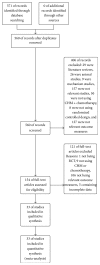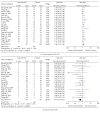Chinese Herbal Medicine as an Adjunctive Therapy for Breast Cancer: A Systematic Review and Meta-Analysis
- PMID: 27239216
- PMCID: PMC4876224
- DOI: 10.1155/2016/9469276
Chinese Herbal Medicine as an Adjunctive Therapy for Breast Cancer: A Systematic Review and Meta-Analysis
Abstract
Chinese herbal medicine (CHM) has been widely used as an adjunctive therapy for breast cancer, while its efficacy remains unexplored. The purpose of this study is to evaluate the efficacy of CHM combined with chemotherapy for breast cancer. The study results showed that CHM combined with chemotherapy significantly increased tumor response and KPS as compared to using chemotherapy alone (RR = 1.36; 95% CI = 1.24-1.48; P < 0.00001; RR = 1.38; 95% CI = 1.26-1.52; P < 0.00001, resp.). Besides, CHM as an adjunctive therapy significantly reduced the nausea and vomiting at toxicity grade of III-IV (RR = 0.37; 95% CI = 0.27-0.52; P < 0.00001). Moreover, the combined therapy significantly prevented the decline of WBC in patients under chemotherapy at toxicity grade of III-IV (RR = 0.49; 95% CI = 0.34-0.69; P < 0.00001) and prevented the decline of platelet at toxicity grade of III-IV or I-IV (RR = 0.29; 95% CI = 0.12-0.73; P = 0.008; RR = 0.77; 95% CI = 0.63-0.94; P = 0.009, resp.). This study suggests that CHM combined with chemotherapy in comparison with chemotherapy alone can significantly enhance tumor response, improve KPS, and alleviate toxicity induced by chemotherapy in breast cancer patients. However, a firm conclusion could not be reached due to the lack of high quality trials and large-scale RCTs, so further trials with higher quality and larger scale are needed.
Figures
Similar articles
-
Efficacy and Safety of Chinese Herbal Medicine on Ovarian Cancer After Reduction Surgery and Adjuvant Chemotherapy: A Systematic Review and Meta-Analysis.Front Oncol. 2019 Aug 16;9:730. doi: 10.3389/fonc.2019.00730. eCollection 2019. Front Oncol. 2019. PMID: 31475101 Free PMC article.
-
Elemene injection as adjunctive treatment to platinum-based chemotherapy in patients with stage III/IV non-small cell lung cancer: A meta-analysis following the PRISMA guidelines.Phytomedicine. 2019 Jun;59:152787. doi: 10.1016/j.phymed.2018.12.010. Epub 2018 Dec 10. Phytomedicine. 2019. PMID: 31005810
-
Oral Chinese Herbal Medicine as an Adjuvant Treatment for Chemotherapy, or Radiotherapy, Induced Myelosuppression: A Systematic Review and Meta-Analysis of Randomized Controlled Trials.Evid Based Complement Alternat Med. 2017;2017:3432750. doi: 10.1155/2017/3432750. Epub 2017 Aug 10. Evid Based Complement Alternat Med. 2017. PMID: 28855947 Free PMC article. Review.
-
Chinese Herbal Medicine as Adjunctive Therapy to Chemotherapy for Breast Cancer: A Systematic Review and Meta-Analysis.Evid Based Complement Alternat Med. 2016;2016:3281968. doi: 10.1155/2016/3281968. Epub 2016 Apr 10. Evid Based Complement Alternat Med. 2016. PMID: 27190531 Free PMC article. Review.
-
Meta-Analysis of Xihuang Pill Efficacy When Combined with Chemotherapy for Treatment of Breast Cancer.Evid Based Complement Alternat Med. 2019 Mar 12;2019:3502460. doi: 10.1155/2019/3502460. eCollection 2019. Evid Based Complement Alternat Med. 2019. PMID: 30992708 Free PMC article. Review.
Cited by
-
Chinese Herbal Medicine, Jian Pi Li Gan Decoction, Improved Survival of Nonresectable Hepatocellular Cancer After Radiofrequency Ablation: A Retrospective Study.Integr Cancer Ther. 2018 Jun;17(2):431-436. doi: 10.1177/1534735417722223. Epub 2017 Jul 26. Integr Cancer Ther. 2018. PMID: 28745082 Free PMC article.
-
The Antitumor and Immunomodulatory Effect of Yanghe Decoction in Breast Cancer Is Related to the Modulation of the JAK/STAT Signaling Pathway.Evid Based Complement Alternat Med. 2018 Nov 18;2018:8460526. doi: 10.1155/2018/8460526. eCollection 2018. Evid Based Complement Alternat Med. 2018. PMID: 30581487 Free PMC article.
-
Astragalus-Containing Chinese Herbal Medicine Combined With Chemotherapy for Cervical Cancer: A Systematic Review and Meta-Analysis.Front Pharmacol. 2021 Jul 30;12:587021. doi: 10.3389/fphar.2021.587021. eCollection 2021. Front Pharmacol. 2021. PMID: 34393766 Free PMC article.
-
Traditional Chinese biomedical preparation (Huaier Granule) for breast cancer: a PRISMA-compliant meta-analysis.Biosci Rep. 2020 Aug 28;40(8):BSR20202509. doi: 10.1042/BSR20202509. Biosci Rep. 2020. PMID: 32789470 Free PMC article.
-
Network pharmacology and in silico approach to study the mechanism of quercetin against breast cancer.In Silico Pharmacol. 2025 Feb 6;13(1):22. doi: 10.1007/s40203-025-00306-8. eCollection 2025. In Silico Pharmacol. 2025. PMID: 39925462
References
-
- Sotiriou C., Neo S.-Y., McShane L. M., et al. Breast cancer classification and prognosis based on gene expression profiles from a population-based study. Proceedings of the National Academy of Sciences of the United States of America. 2003;100(18):10393–10398. doi: 10.1073/pnas.1732912100. - DOI - PMC - PubMed
-
- Sørlie T., Perou C. M., Tibshirani R., et al. Gene expression patterns of breast carcinomas distinguish tumor subclasses with clinical implications. Proceedings of the National Academy of Sciences of the United States of America. 2001;98(19):10869–10874. doi: 10.1073/pnas.191367098. - DOI - PMC - PubMed
Publication types
LinkOut - more resources
Full Text Sources
Other Literature Sources








